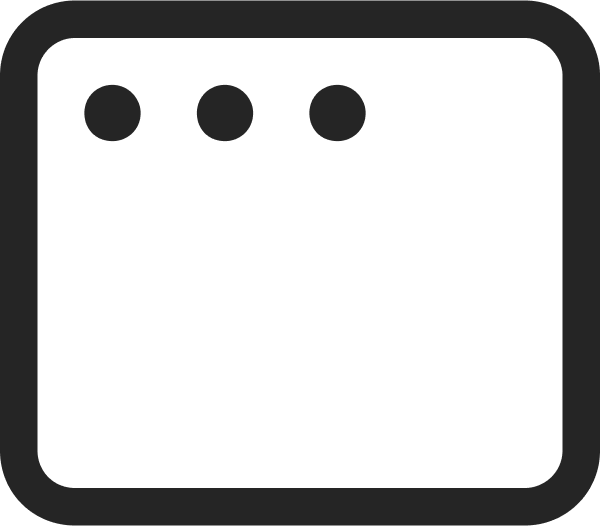The 12 Best Headless CMS for Future-Proofing Your Content
Aug 5, 2022
Words by Shanika Wickramasinghe
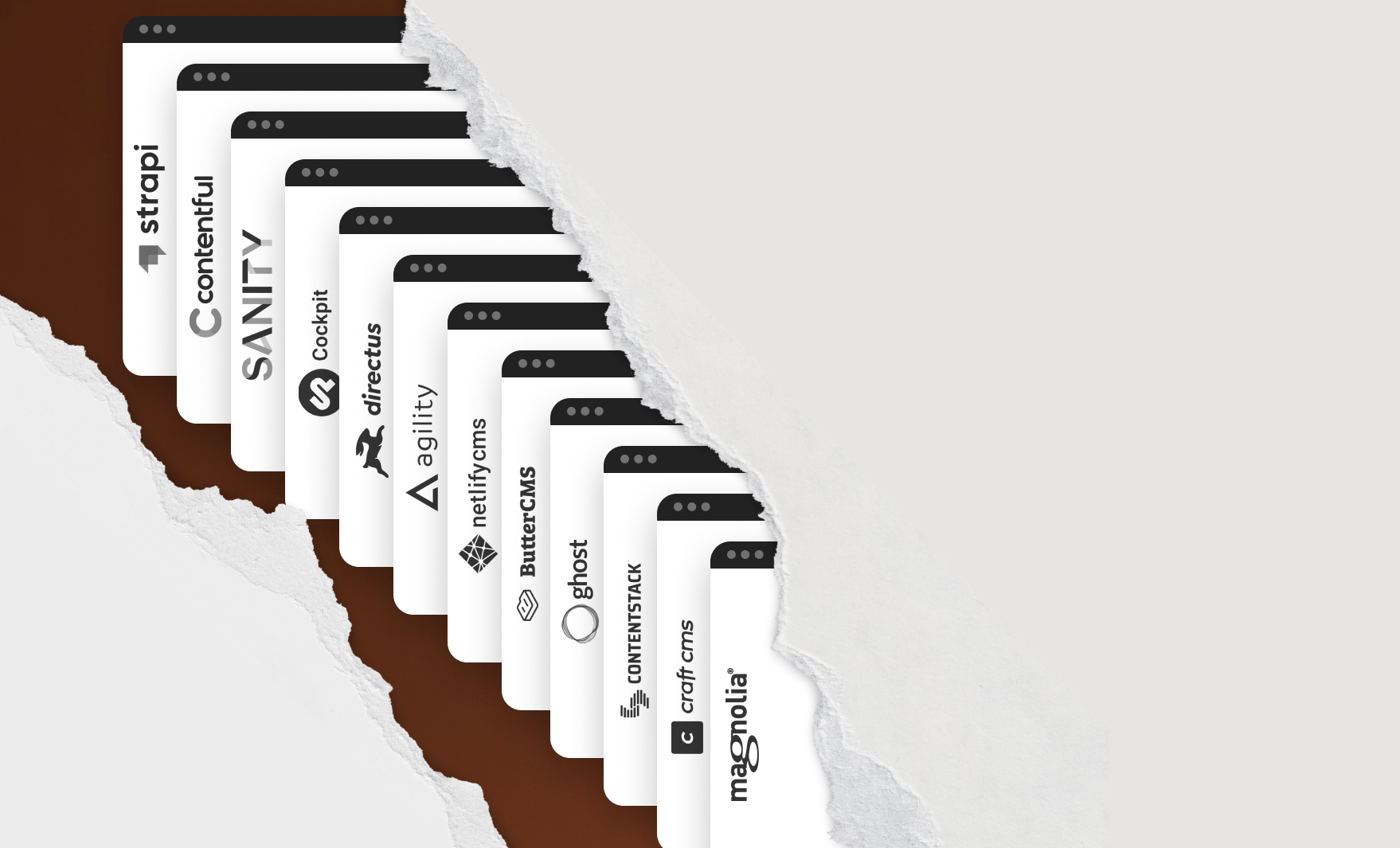
The days of locking your content into one, limited front-end and back-end solution are over—enter the era of the headless CMS.
Choosing a content management system (CMS) for your business can feel a bit like entering a life-long marriage commitment: you need to pick your solution carefully, because you’re going to sink all your content into it, and extracting yourself will be an extremely painful process. That is, until now.
With the rise of the headless CMS, content marketing teams are enjoying new levels of flexibility and control over the evolution of their content. They can capitalize on engaging new web design techniques—including interactivity, scrollytelling content, and immersive 3D worlds—to create cutting-edge, contemporary experiences without needing to haul in a team of developers to expand the rigid confines of their CMS’ front-end.
There are a ton of headless CMS on the market to choose from, and picking the right one obviously involves a lot of feature evaluation. To speed up your research, we’re sharing ours. Here’s our shortlist of the best headless CMS we’ve seen.
Connecting a headless CMS with a no-code front-end builder like Vev lets marketers scale premium content quickly without pestering developers with repetitive work.
Why “Headless” is the Future of Content Management
Headless CMS offer a next-generation solution for managing content. Unlike traditional CMS—also called monolithic CMS—they decouple the back-end repository where your content lives from the front-end where your content is styled. By accessing the back-end using RESTful or GraphQL APIs, they can display your content on any digital product or channel.
This decoupling of back-end and front-end offers a world of benefits. With a traditional CMS, you typically need to use a specific programming language or framework, whereas a headless CMS gives developers the flexibility to work with their preferred programming languages and tools. This is a huge win for efficiency—it means developers with a different area of expertise don’t have to spend a load of time learning how to use the technology.
Headless CMS also enable omnichannel publishing, meaning you need only one headless CMS instance to publish multiple channels and devices using APIs—there’s no need to tailor the content to every channel. Crucially, technical and non-technical creatives can both focus on what they’re best at—either the front-end of how content is styled, or the back-end logic and maintenance of content.
What the Best Headless CMS Looks Like
Before jumping into our shortlist, it’s worth keeping a few criteria in mind as you evaluate different headless CMS options—there are several very similar-looking tools to choose from, after all. The best headless CMS solution for you will, of course, depend on your specific business requirements. Generally, you’ll want to consider these high-level criteria when evaluating solutions:
- Is it open-sourced or closed? Does it include all the security and privacy features required by your business?
- What front-end framework does it need to use—React, Angular, Vue, or Next.js?
- What API query languages are supported and what’s the overall performance of the API?
- How user friendly is it for content creators—not just developers? You need their buy-in too for your solution to work long-term
Best Headless CMS: Our Pick
Here’s our take on some of the best-in-class headless CMS solutions we’ve seen. Almost all of the platforms described here support popular front-end frameworks, like Next.js, React, and Vue.js, and offer a ton of inclusive features to benefit content creators, developers, and editors alike.
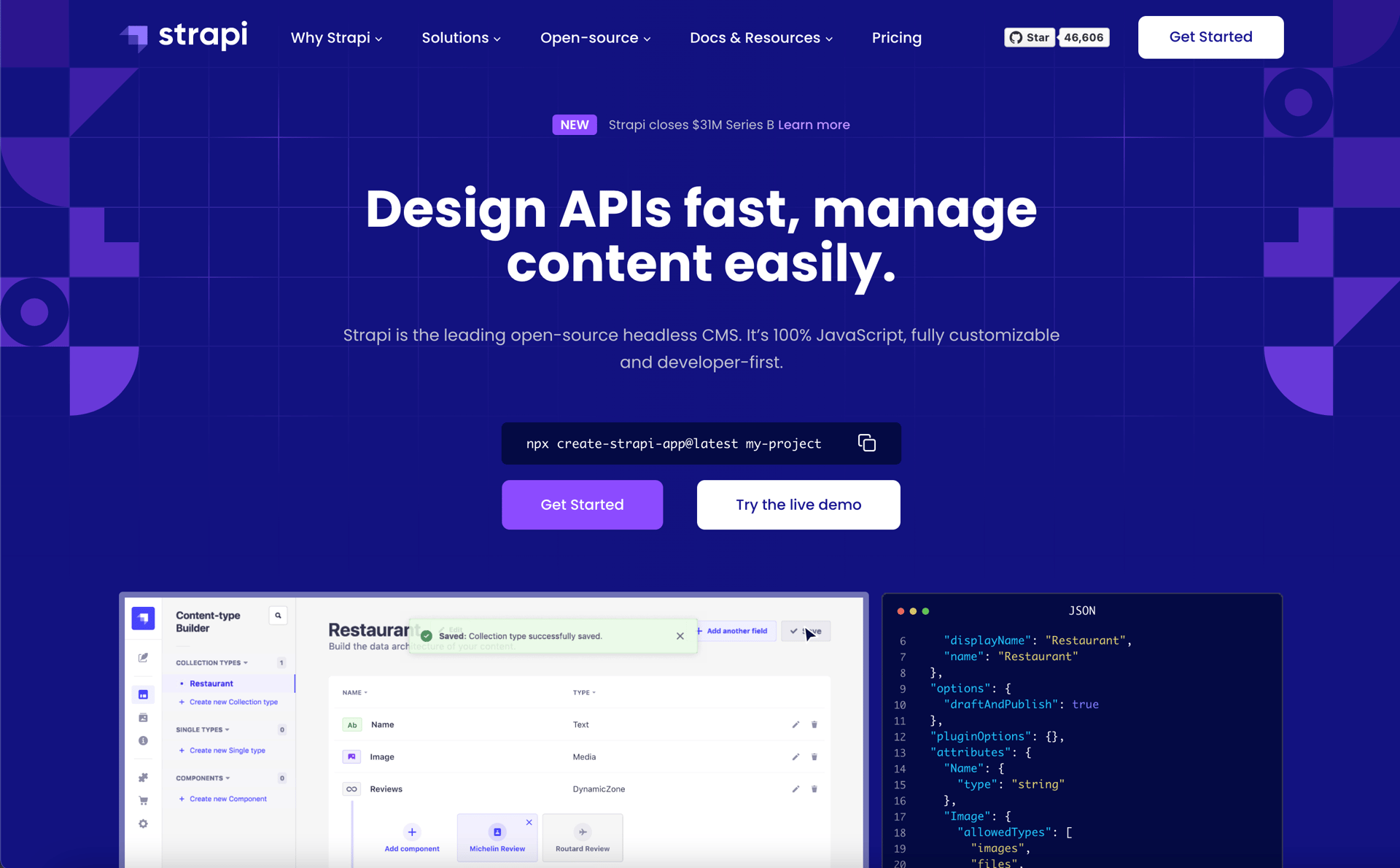
Strapi
Strapi is a leading open-source headless CMS written entirely in JavaScript, boasting many features that allow developers to build a robust headless CMS. Developers can use any client—such as React, Vue, or Angular—to consume the API using REST or GraphQL. It supports a variety of databases, including MySQL, SQLite, MongoDB, and Postgres.
Strapi also allows you to develop custom plugins easily within seconds to extend your CMS. Developers can even use best-in-class third-party tools to make the development experience more intuitive, and—crucially—use their preferred code editor. They don't have to worry about securing the APIs either—Strapi's authentication mechanisms specify API access roles and permissions, so only permitted users can access them. You can also host the CMS in your environment to control data privacy.
Finally, Strapi has a “Content Types Builder” for content creators to build and publish awesome pages, and offers localization features, making it easy to scale multilingual content.

Contentful
Contentful is a cloud-native modern headless CMS with many great features and additional support for faster content delivery—this is actually the headless CMS that we use for all Vev content. It follows a microservices architecture that decouples the read and write APIs, and has advanced caching techniques that can improve API payload delivery time and reduce page load time by supporting AVIF image formats (the best web image format currently available).
Contentful also offers a valuable toolbox for content creators. It features an easy-to-use interface with support for all content types, including JSON, collections, locations, and dates. It also provides multilingual support, security with roles and permissions, and content modeling that enables custom content creation for any channel.
It also supports both REST and GraphQL APIs. We love that content is also optimized for mobile, using techniques such as auto-compression for images and offline persistence.

Sanity
Sanity CMS is a unified content platform for building customizable and extensible CMS. It consists of several different components, such as Sanity Studio, Content Lake, and Image Pipeline. Sanity Studio is an open-source React project where you need to define the content models. It gives you the flexibility to extend your CMS with your own components and build plugins. Content Lake, in contrast, is a fully managed component that runs on the cloud and allows you to store and access your content using via the Sanity API.
Sanity offers robust privacy and security controls, including the ability to assign roles to your users—granting specific access to content. As you’d hope, there are also SSO features, allowing users to log in easily with third-party accounts. Other features worth noting include the image pipeline that lets you transform images on-demand, GraphQL, and GROQ support for querying the documents.
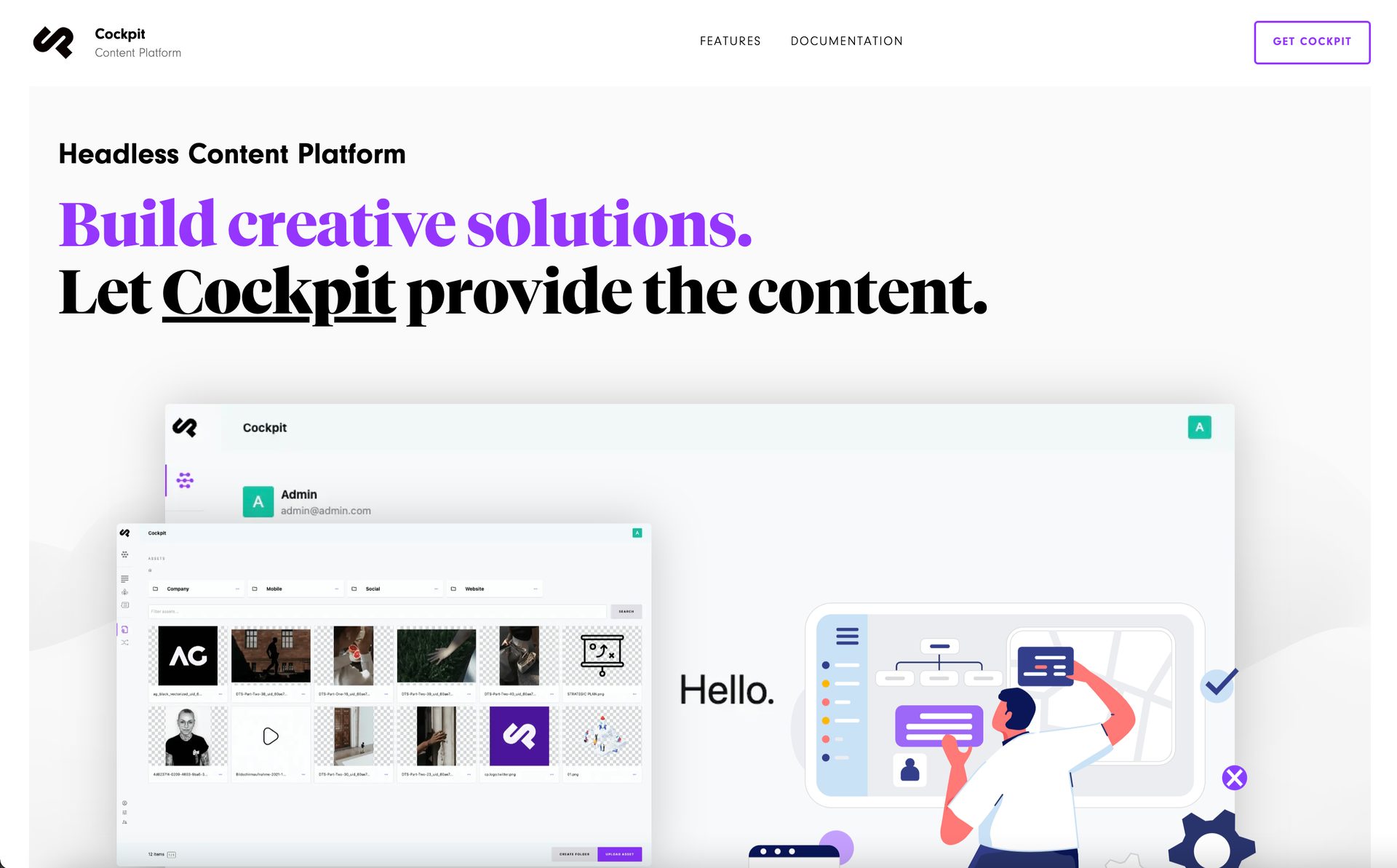
Cockpit CMS
Cockpit is a free and easy-to-install, fully open-source headless CMS. Although Cockpit is a simple platform, it offers users an easy content creation experience. This CMS is self-hosted, meaning you have complete control of your data. One of its key features is its intuitive UX design that lets developers and content creators focus on their work—making it a popular choice with non-technical creatives.
It has a content app that lets users manage the content in one place and distribute them into multiple channels. It also supports common features of headless support like localization and API security with multiple user roles, and lets you add different add-ons, such as webhooks and layouts, to extend functionality.
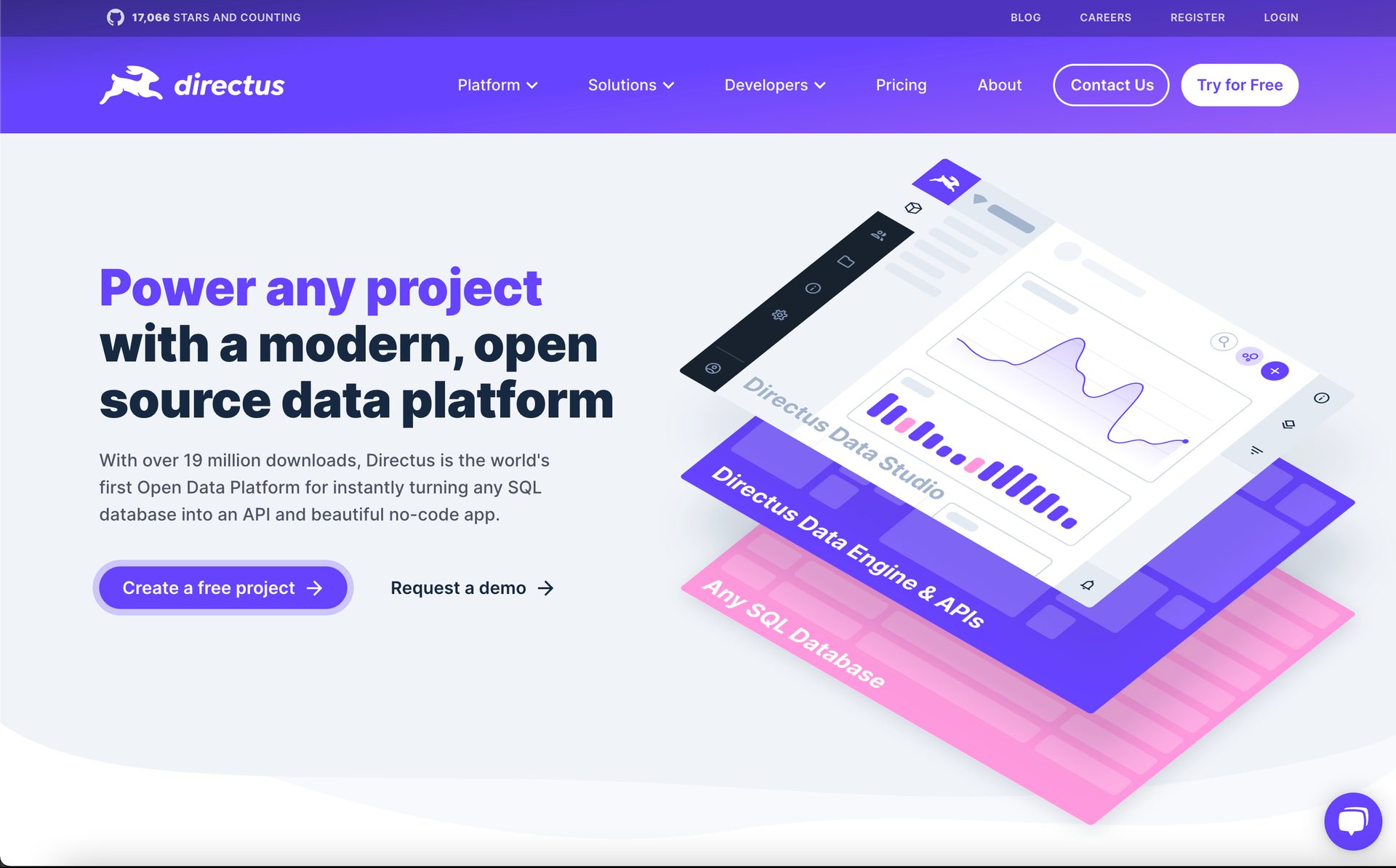
Directus
Directus is an Open Data Platform based on JavaScript and uses Node.js and Vue.js 3 for faster performance. It consists of a headless CMS for content management for various channels like websites, apps, kiosks, and digital signage.
Directus provides facilities to create REST and GraphQL APIs within minutes. One of our favorite features is its support for a wide array of databases, including modern cloud-based databases like OracleDB, CockroachDB, MariaDB, and Aurora. It also offers authentication options, like secure two-factor authentication with access control and asset management mechanisms.
As a big plus for the content creator experience, Directus also provides visualization tools, customizable dashboards, and charts, with multiple integrations and presentation choices.
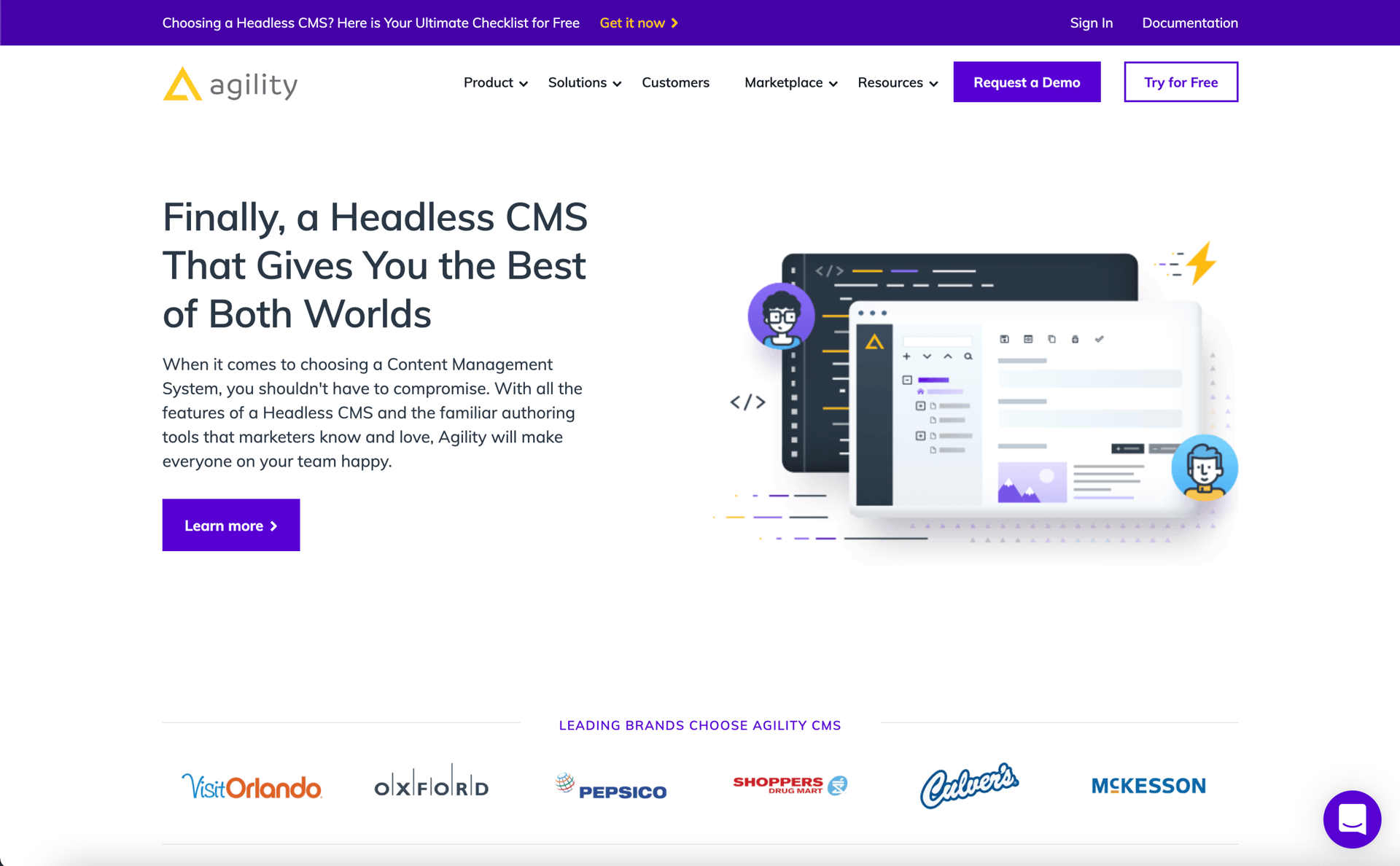
Agility CMS
Agility is an API-first flexible headless CMS that allows you to build and manage solutions for multiple digital channels. Packed with features, it’s a top choice for developers and marketers alike.
Developers can build CMS solutions using any programming language or front-end framework. Content can be delivered to multiple channels providing an omnichannel experience, and Agility’s authoring and content preview tools make it super easy to manage content across different channels.
Agility is also a winner for flexibility. It offers an intuitive interface and integrates with tools like Salesforce, Youtube, and Paypal. It also prides itself for its focus on performance, scalability, and security options. This API-First cloud-native platform is hosted in Microsoft Azure. It’s also worth calling out its Standard Encryption, Single Sign-On (SSO) capability, multilingual support, and content analytics tools—all of which make it very marketer friendly.
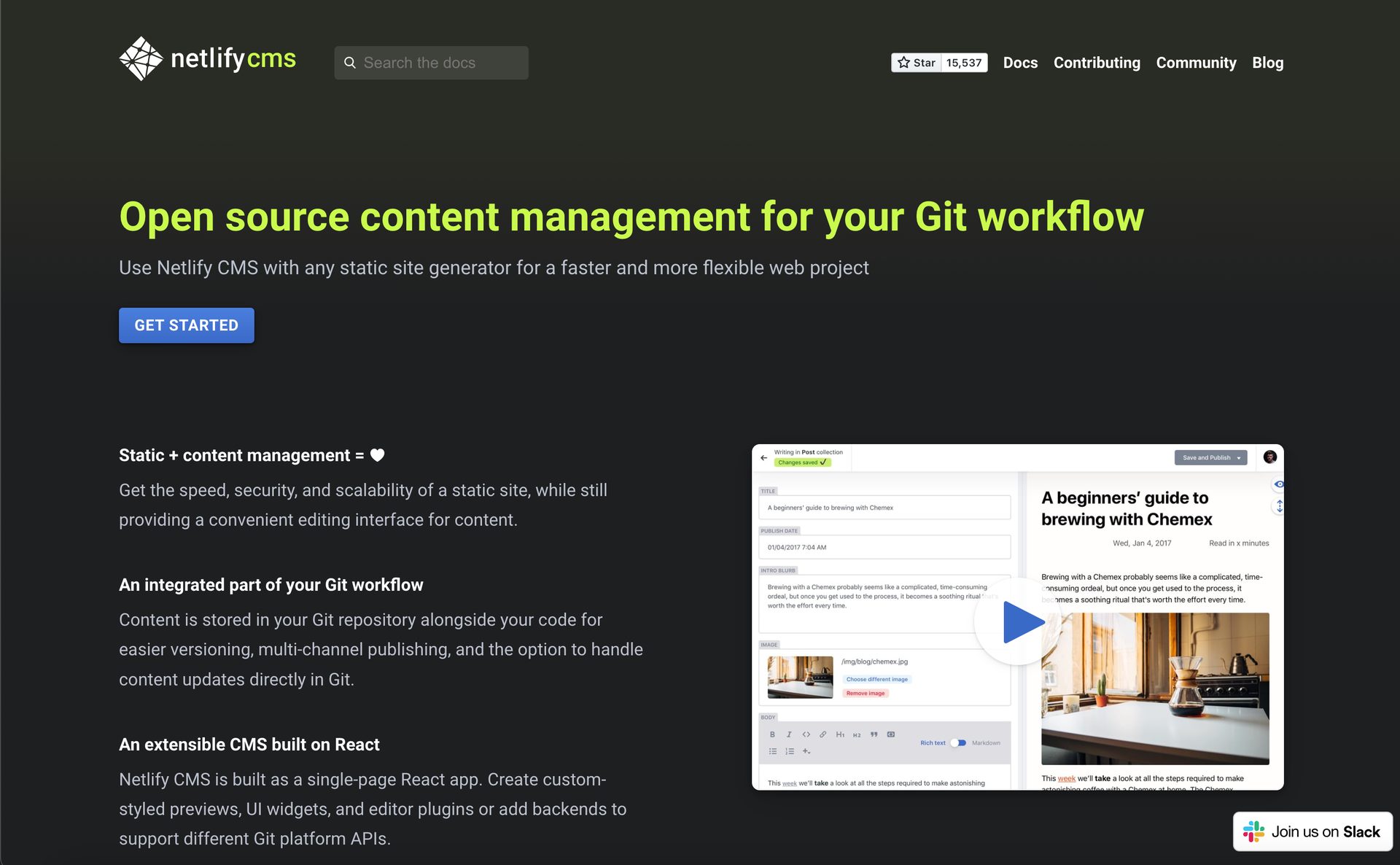
Netlify CMS
Netlify CMS is an open-source headless CMS built as a single-page React app. It helps manage static content that can be integrated into Git workflows. This means that content is stored in a Git repository with your code for super easy versioning—you can update the content directly using Git. The Git Gateway feature of Netlify allows you to provide CMS access for team members without a GitHub account.
One of the best features of Netlify is its user-friendly web-based interface. It offers marketers an intuitive editing experience, with helpful features like drag and drop, rich-text editing, and real-time preview. Its content workflows allow writers and editors to manage content easily using a simple “draft”, “review” and “ready” status system.
We love that Netlify offers modern authentication mechanisms like authentication using GitHub, GitLab, or Bitbucket and JSON web tokens. It also offers extremely flexible content types—you can use custom fields and extend your CMS using plugins, UI widgets, custom-styled previews, and more.

Butter CMS
Butter is another great developer-friendly choice. Developers can use any tech stack they want with its global content API (and documentation around this is really comprehensive), and the platform manages all security and maintenance so developers can just focus on development.
Butter’s super fast content API ouses caching to increase performance, scalability, and resilience, and it also manages security as a SaaS platform. The whole content modeling system is really flexible—including components, different page types, collections, a pre-built blog engine, and more. Content creators will appreciate its media library, where audio and video can be easily managed.

Ghost CMS
One of the more niche headless CMS out there, Ghost CMS is an open-source publishing platform based on Node.js. It can also be used as a headless CMS using popular third-party front-end frameworks including Next.js, and is probably one of the best headless CMS out there for Gatsby and Vue.js. Its default front-end layer is based on Handlebars, but it’s still super flexible and they have detailed setup guides on how to use their platform as a headless CMS.
Overall, Ghost CMS offers a great user experience for non-technical creators, and is ideal for creating blog articles and newsletters. Integrations with popular apps and software mean you can extend CMS functionalities further.

Contentstack
Contentstack is an enterprise-level, cloud-based headless CMS that provides an easy user experience. Its stand-out feature is its central content hub,—a single content source that makes maintenance easier while reducing costs. Contentstack’s simple UI streamlines the content creation workflow from creation to publication, making it a breeze for marketers.
You can further expand content by using extensions, apps, and integrations from Contentstack’s Marketplace, and modular content make it a top choice for content reusability, localization support, and collaboration. The whole things is hosted in Microsoft Azure, enabling users to run Contentstack apps on their preferred cloud provider. As you’d expect, there are lots of built-in security mechanisms, from data encryption and two-factor authentication, to password protection.

Craft CMS
Another lesser known headless CMS, Craft CMS is a very user-friendly CMS with many features for designing and managing content. Its intuitive authoring experience makes it popular among non-technical users—who enjoy features like custom fields, section types, categories, and tags. It also offers localization support by storing content on a per-site basis.
As a bonus, Craft CMS offers easy integration with marketing tools like Salesforce, Mailchimp, and Hubspot. You can also add plugins using its Plugin Store and plugin framework.
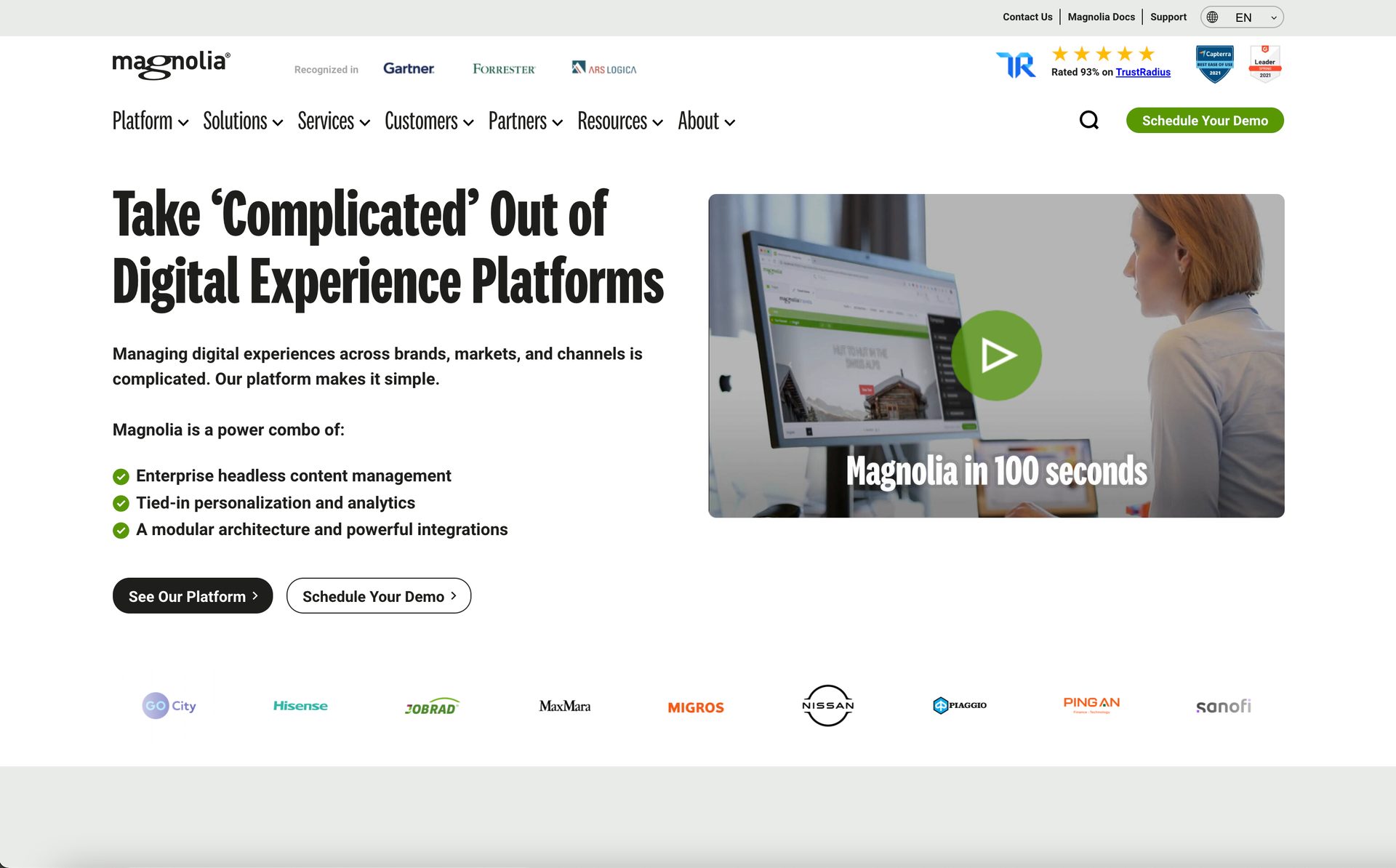
Magnolia
Magnolia CMS is another great choice for React, Angular, Vue frameworks. You can integrate it with Single Page Applications, whose front-end also supports any of those frameworks. Its delivery API lets you connect content to any channel, and its templating API enables marketing teams to edit web applications.
Magnolia offers a visual user interface for content authors with features like WYSIWYG editing, experience preview, personalization, and analytics. It offers connectors to build unified platforms if you want to connect your headless CMS with other applications like eCommerce and CRM.
Key Takeaways
Headless CMS are the future of content management due to their decoupling approach and omnichannel publishing support.
While you’ll still likely want to choose a headless CMS once and stick with it, the cost of switching down the line is so much smaller than with a traditional CMS.
It’s hard to go wrong with any of the options covered on this list—just make sure the solution you pick benefits non-technical end-users, as well as developers.
Front-end freedom for any back-end
Vev empowers marketers to scale cutting-edge content without fighting their CMS. By dragging and dropping pre-coded design components, marketers can visually design the front-end of websites and landing pages—creating complex scrollytelling, parallax, and interactive experiences without involving developers or touching the CMS back-end. Just connect a headless CMS with Vev for complete front-end freedom.
Want More Inspo?
Get our monthly newsletter straight to your inbox.
You can always unsubscribe at any time.
Privacy Policy













